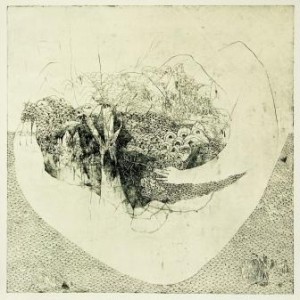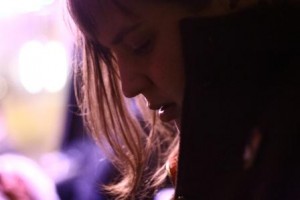VISUAL ARTS: Matters of scale and intricacy
When I first noticed Lisa Rezansoff, it took about half a six-pack of Pils to realize I was at the table of a born artist.
Almost unconsciously her pen-in-hand would pattern some of the most marvellous things our group of drifters had ever seen, a new language of drawing that made us think of dreams you might get dozing off on the couch with Yellow Submarine playing on TV. Trees drawn in beet juice; planetary eruptions of toothy buildings all over the phonebook; over and over, her icon: a round-faced little girl in a hoodie, eternally lost amid unguessed shapes as unique as puddles. Lisa’s lines danced with a musical pleasure people go to university for years to hone in on as their ultimately “considered” style. Rezansoff seemed like she’d be doodling in her own afterbirth before her eyes knew how to focus.
Her show opening tonight (Friday, March 4) at Latitude 53 is a matter of substrates and mediums, I guess scale and intricacy, as well – but the lines and the patterns have proven away a thing I’d secretly feared: that years of university might destroy her. Control her weather patterns, if you take my meaning. Make her over-think the incalculable. Sure, I’ve watched her mature, my favourite piece of hers a couple years back being marker illustrations covering the outstretched windows of Jekyll and Hyde, an organic city she grew inch by inch on glass over top the parkade roots of the Chateau Lacombe. It was fucking beautiful.
But, thank God, says Lisa: “I still doodle in my spare time. I have to doodle to keep my brain, eyes, heart and hand in good shape and tuned up with one another. I have to always be reminding myself that line does exist, how it feels and looks, that it’s still there. When I’m totally free to doodle for fun, that’s when some serious stories can come out. It’s when I get caught up in interesting and unexpected shapes and pattern. It’s important to always doodle, then when the time comes to start more intense and sustained work, this feeling of freedom and playfulness carries over, and you remember what the doodling taught you. It’s not always that easy, though. I’ve found since being in school, I don’t doodle as much as I used to. But I did pick up a lot of other useful stuff, and I can still do what i like, so it’s all working out, I think.”
Why, yes. From those looseleaf pages and scribbled-full phone directories, we now have an artist who carves, sculpts, etches on copper, prints. If you don’t mind, she’ll describe the process: “I love the copper, it has this unique way of transforming the language of a hand-drawn image into a rich and multilayered artifact. I’m fascinated by how the image can acquire such a depth and dignity through the translated memory of the plate. The end result is so unified, and looks like it’s been there for a hundred years.
“In the first stage of the drawing, I use a soft ground technique. I’m able to get a big range of line weights and tone, can move from slow, soft methodical marks to fast, hard and scribbly, because I’m drawing with just a pencil on paper that sits over top of a ground that coats the copper! When I etch it in a bath of ferric chloride, the marks I made get mixed up with lots of unexpected organic marks that happen through the beautiful and mysterious personality of the copper. I’m trying to harness that.
“The last step is inking up the plate, laying it down with new paper, and pulling it through the press. This builds my arm muscles,” she says like a tough guy. “The print ends up richer, darker, and more layered than the original drawing. And there are so many possibilities to keep adding and changing it, to use different techniques over top of the same image, it seems endless.”
SNAP Gallery now has Lisa working in its belly. She’s happily nestled within a four-month studio scholarship the printmaking gallery offered to senior students at U of A, where Rezansoff blossomed. She had to submit images of her work, a CV, a letter of intent, the usual stuff, but she’s happy to transition at the studio, one of many breathing relief their operating budgets weren’t jeopardized by the province this round.
“If it wasn’t for the SNAP studio, I would have no place to do copper etching at all! So I’m really thankful, because I’m really into it right now, it’s a beautiful medium. With this scholarship, I get free access to the studio 24 hours a day for four months, and there’s supposed to be an exhibition in the gallery with the other recipients in August. It’s a good transition into the – quote – real world after university.
“I can do what I did before, but better I think. I’m comfortable with all kinds of media now, with mixing things up, and working in different scales. I’ve learned a lot about how to see and draw from observation and different approaches to composition, about colour, things like that. I know it has all in some way or another changed the overall look, probably for the better. Even though I’m back to drawing from memory and my imagination, all those exercises and hours of work have made me better at what I like to do. School forces you pump out a lot of work, and lots of it I didn’t like,” admits the artist.
“Looking back at what I did before school, it’s hard to pinpoint exactly how the look has changed, I just know that now I can envision things differently, there’s more visual depth, more layers. Plus I had no idea what printmaking was really, before the U of A.
“Thanks, school!” She says this, personifying. But if you look at her work you’ll understand. Rezansoff has a way of making anything she brushes against come alive.
Her show runs in Latitude’s Projex Room until April 2.













